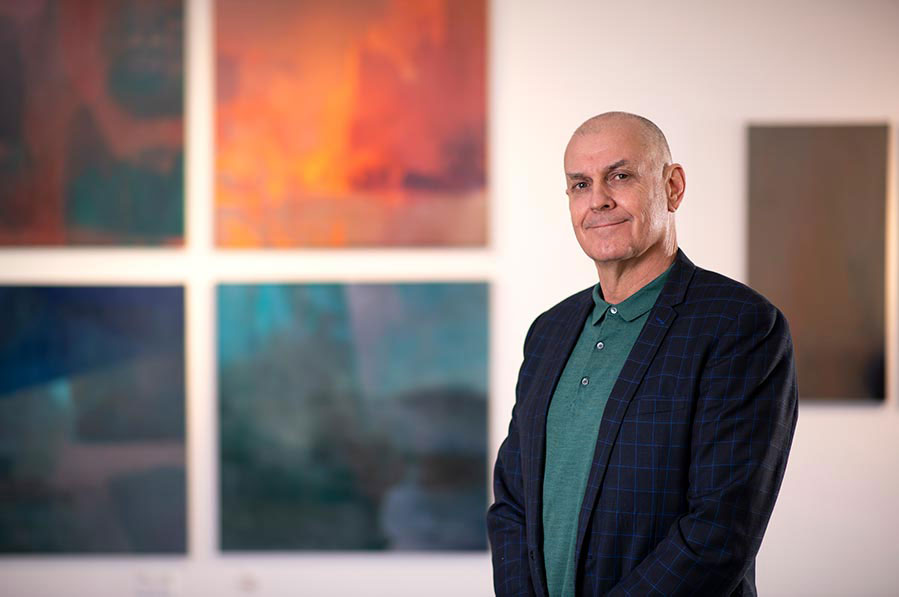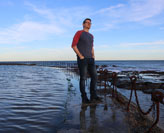
Associate Professor Mark Roxburgh
Honorary Associate Professor
School of Humanities, Creative Ind and Social Sci
- Email:mark.roxburgh@newcastle.edu.au
- Phone:(02) 4921 5790
The future of design education
Associate Professor Mark Roxburgh’s research is shaping the future of design education in the face of increasing challenges from automation.

What is the future of design and visual communication practice in the world of artificial intelligence and automation? That is the question Associate Mark Professor Roxburgh aims to answer through his research that investigates how conventional approaches to design education need to change to meet the challenges of our increasingly artificial world.
A lecturer and researcher in visual communications and design, Roxburgh says that design work is extremely vulnerable to automation and artificial intelligence.
“Software is already available that can automate many visual communication projects, such as Wix websites and logo maker and Squarespace, and these are cutting out jobs for graduates,” he said.
“The definition of work that is vulnerable to artificial intelligence and automation is anything that is repetitive and that is done in a stable environment. Page layout for print and web design is highly repetitive and a personal computer is a stable environment, therefore those areas of expertise are very vulnerable,” he said.
“I’m interested pinpointing the threats facing the industry and what we can do educationally to negate those threats. I want to figure out how we should adapt our curriculum so our graduates won’t be replaced by machines.”
Going down the bespoke and hand crafted route is one way to beat the machines, however Associate Professor Roxburgh says another approach is to shift design practice away from being concerned with the crafting of the visual aesthetic on a digital platform towards managing the process through which design decisions are made.
“It’s taking the visual skills students have into different forms of practice where they are being used more in the process of ideation rather than crafting an outcome.”
It’s this kind of work that Roxburgh facilitates for his Honours and PhD students. Over the past few years he has facilitated groups of students on embedded placements at NIB Health Funds and Westpac, where they work in user centered design using their visual communication skills.
“I initially had 15 students working with Westpac using design research methods to improve customer experience. The topic was the future of banking and the students completed a series of design research techniques and communicated what they discovered about the topic through visual forms. They came up with a design concept they presented visually, for example ATM’s that were drones you can call on your phone and apps that aggregated your spending based on categories so if you were spending too much money on going out to bars you would have a meter that alerted you,” he said.
“That project was hugely successful and demonstrated to the bank just what can be achieved through user experience research and design.”
Roxburgh believes the term work integrated learning should be reversed.
“What my honours students are doing is learning integrated work. They are embedded in the industry for a significant amount of time, primarily engaged with the organisation and dealing with the university only one hour a week. They are value adding and managing their learning rather than coming to university,” he said.
He suggests that the conventional approach to design education is redundant and that on demand learning is the way of the future.
“We have this semester drip-feed model of education. But that is not the way of the world anymore. You can learn how to do anything via YouTube these days and I believe we need to adapt our model of design education to meet the changing needs of today’s students.”
How photographs shape our world
The capacity to design is a fundamental human trait, according to Associate Professor Roxburgh.
“We all design in small ways, from rearranging the furniture at home to designing cities; it’s a profound human activity,” Associate Professor Roxburgh said.
Consequently, design shapes the world we inhabit and Roxburgh that it should come as no surprise that the world is becoming increasingly artificial, or human made. His forthcoming book with the working title The Design Photo, discusses the manner in which the explosion of digital photographs on social media platforms are impacting our imagination and the artificial world we live in.
“The key argument of the book centres around the phrase, ‘you can’t be if it you don't see it’, as this is the premise of design,” he said. “Design is first and foremost about generating images showing us what the world can be like. The role of the image and its relationship to imagination and perception is central to how we design.”
Associate Professor Roxburgh says the dominant image of this century is the photograph and with the advent of social media the photo has become ubiquitous and largely influences how we view the world.
“My argument is philosophical and is that the images that we take and circulate on social media are not candid but are to some extent contrived. Research has been done that indicates that people curate a representation of themselves and their world through the images they put on social media. That influences how we see the world and how we imagine the world can be,” he said.
“We tend to now imagine the world in photographic terms because that is the dominant image form we see and our social reality is conditioned by this.”
Battling designer burn out
In another research project Associate Professor Roxburgh is investigating the phenomenon of designer burn out. He says that anecdotally many designers leave the field in their 40s due to boredom.
“There is a massive churn in the industry where designers hit a certain point in their career and then decide to quit,” he said. “The reality is that in commercial practice designers are working under enormous constraints and the work becomes quite repetitive so people get bored and burnt out.”
Roxburgh is leading a research project that examines how visual communication practitioners maintain their creative enthusiasm.
“I’m having conversations with senior designers that have managed to keep working in the industry into their 50s and 60s and am discovering what keeps them going is that they do side projects that are not directly related to how they earn a living. This then satisfies their desire for creativity,” he observed.
Roxburgh came across this phenomenon when he curated an exhibition in 2006 that featured 25 prominent Australian designers who chose a piece of work and shared the story of how it came into being.
“Through that process I discovered lot of them did things outside of their 9 to 5 work to keep them engaged with the creative process because they weren’t getting that deep satisfaction from their commercial work. I’m interested in what lessons we can learn about that to feed into design education and hopefully reduce the burn out rate”.
“My instinct is that unless you provide space in design education for free thinking approaches to design you will constrain people’s capacity to imagine things.”
The future of design education
Associate Professor Mark Roxburgh’s research is shaping the future of design education in the face of increasing challenges from automation.What is the future of design and visual communication practice in the world of artificial intelligence and automation? That is the…
News
News • 13 May 2016
UON PhD candidate's film to have world premiere in Hollywood
Filmmaker Stuart McBratney is studying a PhD by creative work at UON: and as part of his candidature, he’s written, directed and composed a feature film set for the silver screen in Hollywood.
Associate Professor Mark Roxburgh
Position
Honorary Associate Professor
FunTeam
School of Humanities, Creative Ind and Social Sci
College of Human and Social Futures
Contact Details
| mark.roxburgh@newcastle.edu.au | |
| Phone | (02) 4921 5790 |
Office
| Room | X-839 |
|---|---|
| Building | X - Nuspace |
| Location | City , |


